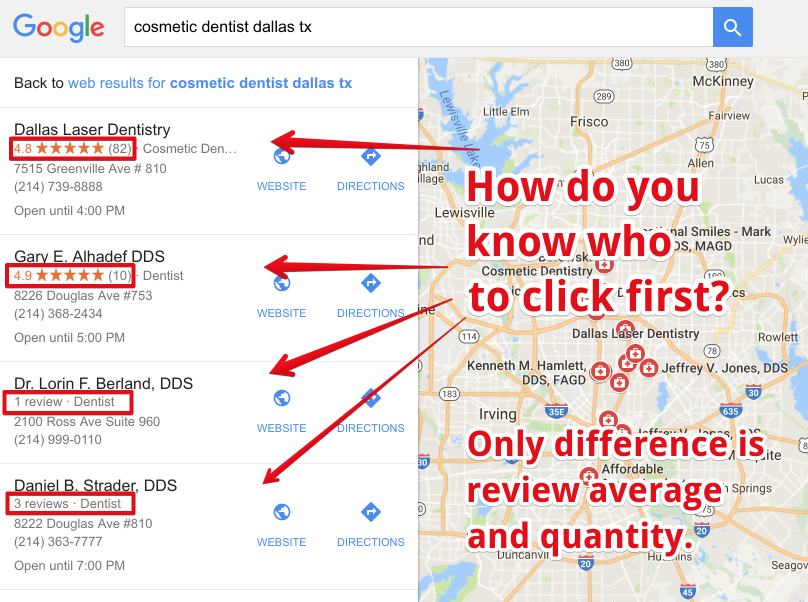Think about the last time you shared a post on your practice’s Facebook page, and you’re pretty sure it was awesome…
but it just didn’t get the engagement you were hoping for.
Maybe it’s a new blog post on your website. Or a video you made in the office.
When that happens, it’s not because the content isn’t great. More often than not, it’s the context you create (or lack thereof).
Social media is tricky because people aren’t actively looking for the solution you’re selling. To get someone to stop what they’re doing and engage with you is not an easy task.
Fortunately, there are a few tricks you can use to make your Facebook posts more persuasive, and get more of your target audience to comply with your requests — click, watch, share, whatever.
Let’s talk about 4 of these simple tricks now:
1. Focus Around Their Problem, Not Your Solution
This happens all the time. You as a medical professional have a number of solutions to patient problems. And you want to share those solutions with the world. That’s all good.
The mistake is to frame everything around the solutions you offer… and not around the patient’s problem.
For example, if you’re a LASIK surgeon, here’s how not to start a post:
“Do you cringe at the thought of an eye procedure, like LASIK?”
Eek, not good.
But what are the problems here?
1 . We’re talking about our solution (LASIK), not their problem (bad vision, frustrations with glasses/contacts, limitations to life, anything).
2. Therefore, we’re associating negativity (cringing at the thought of something) with the solution (LASIK). Forget about helping your position, this actually hurts it.
3. And we’ve completely overlooked our most persuasive talking point — the patient’s own negative experiences with their current vision solutions.
A better option?
“Do you cringe at the thought of getting sand stuck in your contact lens?”
Now we’re focused on the problem the patient is experiencing — contact lenses are awful.
BONUS: We know patients have experienced this before. What contact wearer hasn’t gotten sand stuck under his/her contacts? This makes for persuasive content, because we aren’t dealing in hypotheticals. It’s real life.
From there, you may want to tease an article like so:
“With beach season coming up, we asked people to compare their LASIK procedures with that oh-so-fun feeling of getting sand caught under their contact lenses…”
See what I’m doing here?
Another example, in the orthodontic space:
BAD:
“Do you cringe at the thought of wearing braces as an adult?”
This is focused on the solution + draws negativity to it = not persuasive.
RAD:
“Do you cringe at the thought of another new client meeting because you’re embarrassed to show your smile?”
In contrast, now we’re focused on the problem, highlighting a frustration the prospect has. Then we walk toward the light, i.e. your solution.
2. Use Numbers Instead of Percentages.
This is an easy one. When it comes to sharing a statistic, use an actual number and not a percentage.
Our brains have trouble turning percentages into mental pictures, which means percentages aren’t nearly as persuasive as the data they represent.
BAD
“90% of people were highly satisfied with their treatment.”
RAD
“9 out of 10 people surveyed said they were so excited with their results, they would do it again in a heartbeat.”
Easy as that. Convert your percentages to actual numbers, and give them some flavor and context so your prospect can “picture” what the numbers represent.
3. Don’t reveal the punchline in the post
This is a big one.
You want people to take action on your post, right? Watch the video. Read the article. Take the self-test.
Well, if you share the punchline — the result, the conclusion — in the post itself, why would anyone engage with it?
“Man Attempts Bank Robbery During Lunch Break. Cops Take Him Down. No One Died.”
Who’s clicking on that? No one. We already know the story. NEXT.
Make it a point NOT to “give it all away” in the text of your post.
4. Use “click bait” to get the viewer to take action
This piggybacks on the previous point. Not only should you keep the punchline a secret, you also need to actively encourage people to engage.
This means using a type of writing called “click bait.” Stick with me here.
You’ve probably heard of click bait. And I hope you don’t turn a deaf ear when I use that term.
While click bait is typically associated with online “fake news” outlets, it’s actually an effective tool to get people to take action. And it doesn’t have to be sleazy.
So what is click bait? At its core, you’re creating a scenario in which curiosity overcomes the prospect and they can’t help but click to satisfy that curiosity.
You see this all the time on your Facebook feed.
“Man saves cat from tree. What happened next left the neighbors stunned!”
HEY, what happened to that dude? And the cat? I need to know. **CLICK**
That’s clickbait.
It doesn’t have to be so spammy sounding. Here are a few of what I would call ‘above-board’ click bait posts.
LASIK — “We asked her to tell us how she felt in the moments after her LASIK procedure. Her response left our office staff speechless.”
ORTHO — “Think you can spot the one with ceramic braces? This picture had the entire office baffled.”
OPTOM — “DRESS TEST: Blue and black OR gold and white? You be the judge.”
All of those are click-bait style teasers designed to get the engagement.
The trick with click-bait is this:
Make the hook ambiguous enough so the reader doesn’t know if it’s teasing something really good or really bad.
In example one — ”Her response left our office staff speechless.” In a good way? In a bad way? Who knows. CLICK AND FIND OUT.
You’re all set.
Now you have no excuse to write non-persuasive social media posts. Get out there today and start testing your newfound knowledge.
And to make sure you don’t miss a post, click here to join my private email list if you haven’t already. If you like this, you’ll love the juicy nuggets I share in the privacy of your inbox.

